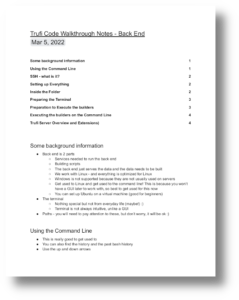Trufi mobile apps – whether Android or iOS versions – need to communicate with a back-end server to stay up to date on public transport routes, or any other data that the app consumes.
Of course our back end is open source, and available on GitHub (here). But it’s always helpful to have an expert to guide developers through how the code works. Our back-end expert, Sören Reinecke, provided a guided walkthrough for a few developers in March, 2022. These are the recordings of that guided tour.
Trufi Back End Code Walkthrough
Notes from the Walkthrough
If you’re a developer and you want learn about how Trufi apps are put together, here are notes from the walkthrough.
About the Trufi Back End
The back end is the endpoint server with which our mobile applications communicate over the internet (over a secure HTTPs connection). It is in charge of handling all requests from the client application – the mobile app. For example, to calculate the user’s journey and to return them back, or providing the maps seen in the app.
Everything is made possible with open source code: The journey planner, OpenTripPlanner, and the Maptiler-Gl which takes care of the background map. These services use open data by submitted by OpenStreetMap contributors.
To provide search functionality we use Photon by Komoot which uses an open data search index from OpenStreetMap data.
Questions? Want to Join Us?
Something in the video was not clear? You just want to know more about the back end or Trufi Core? You’re a developer and want to contribute to the code? You want to develop your own app?
Contact us using this form. Let us know if you would like to be included in any future guided tours of the code.

 Subscribe to Trufi's Channel
Subscribe to Trufi's Channel
Pingback: weeklyOSM 625 – weekly – semanario – hebdo – 週刊 – týdeník – Wochennotiz – 주간 – tygodnik
Pingback: Volunteer of the Month: Sören Reinecke - Trufi Association